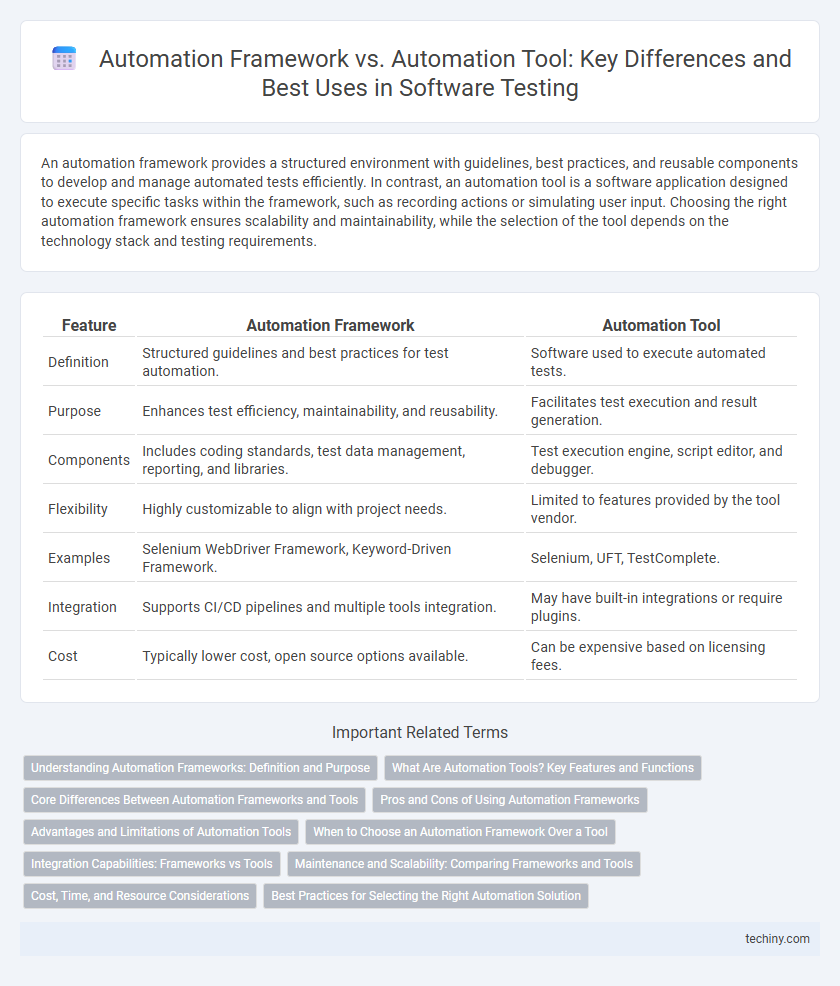An automation framework provides a structured environment with guidelines, best practices, and reusable components to develop and manage automated tests efficiently. In contrast, an automation tool is a software application designed to execute specific tasks within the framework, such as recording actions or simulating user input. Choosing the right automation framework ensures scalability and maintainability, while the selection of the tool depends on the technology stack and testing requirements.
Table of Comparison
| Feature | Automation Framework | Automation Tool |
|---|---|---|
| Definition | Structured guidelines and best practices for test automation. | Software used to execute automated tests. |
| Purpose | Enhances test efficiency, maintainability, and reusability. | Facilitates test execution and result generation. |
| Components | Includes coding standards, test data management, reporting, and libraries. | Test execution engine, script editor, and debugger. |
| Flexibility | Highly customizable to align with project needs. | Limited to features provided by the tool vendor. |
| Examples | Selenium WebDriver Framework, Keyword-Driven Framework. | Selenium, UFT, TestComplete. |
| Integration | Supports CI/CD pipelines and multiple tools integration. | May have built-in integrations or require plugins. |
| Cost | Typically lower cost, open source options available. | Can be expensive based on licensing fees. |
Understanding Automation Frameworks: Definition and Purpose
Automation frameworks provide a structured environment that integrates multiple automation tools, coding standards, and best practices to streamline test automation processes and improve consistency. They define guidelines, reusable components, and reporting mechanisms that enhance scalability and maintainability in automated testing efforts. Unlike standalone automation tools that focus on executing specific tasks, frameworks offer a comprehensive solution to managing test automation lifecycle efficiently.
What Are Automation Tools? Key Features and Functions
Automation tools are software applications designed to execute repetitive tasks, streamline workflows, and improve efficiency by automating manual processes in development, testing, or operations. Key features of automation tools include scriptless automation, integration with multiple platforms, real-time reporting, and support for diverse programming languages. Their core functions involve task scheduling, execution monitoring, error handling, and seamless integration with continuous integration/continuous deployment (CI/CD) pipelines to accelerate software delivery cycles.
Core Differences Between Automation Frameworks and Tools
Automation frameworks provide a structured environment with predefined guidelines, coding standards, and reusable components designed to support automated testing processes, while automation tools are software applications that execute specific tasks or test scripts within those frameworks. Frameworks enable integration of multiple tools and facilitate maintainability, scalability, and consistency across test cycles, whereas tools focus on individual functionalities like test case execution, reporting, or defect tracking. Core differences lie in frameworks' overarching architecture that governs automation strategy versus tools' specialized capabilities executing parts of that strategy.
Pros and Cons of Using Automation Frameworks
Automation frameworks provide a structured environment that enhances script reusability, maintainability, and scalability, reducing test execution time and improving accuracy. However, implementing a framework requires significant initial investment in time and expertise, with ongoing maintenance demands to adapt to changing requirements. In contrast to standalone automation tools, frameworks integrate multiple tools and support collaborative development, but their complexity can pose challenges for teams lacking automation experience.
Advantages and Limitations of Automation Tools
Automation tools offer the advantage of simplifying repetitive tasks with pre-built functionalities and user-friendly interfaces, accelerating test script creation and execution. However, these tools often have limitations such as reduced flexibility for complex test scenarios, dependency on specific platforms or environments, and potential high licensing costs. Choosing the right automation tool requires balancing ease of use and coverage against these constraints to ensure effective automation implementation.
When to Choose an Automation Framework Over a Tool
An automation framework is ideal when projects demand structured scripts, reusable components, and scalability across multiple test cases, offering comprehensive support for test management and reporting. Choose an automation framework when the goal is to build a robust, maintainable testing process that integrates with CI/CD pipelines and supports various testing types like UI, API, and performance testing. In contrast, a standalone automation tool suits simpler, one-off testing needs without requiring extensive customization or integration.
Integration Capabilities: Frameworks vs Tools
Automation frameworks provide robust integration capabilities by supporting multiple tools, languages, and environments, enabling seamless orchestration of diverse testing and deployment processes. Automation tools often focus on specific functionalities with limited integration scope, restricting their ability to operate within complex workflows. Frameworks facilitate smoother data exchange and interoperability, essential for continuous integration and continuous delivery (CI/CD) pipelines in modern DevOps environments.
Maintenance and Scalability: Comparing Frameworks and Tools
Automation frameworks provide a structured approach promoting maintainability and scalability by organizing test scripts and supporting reusable components. Automation tools focus on executing specific tasks but may lack the comprehensive architecture needed for easy updates and scaling across large projects. Frameworks enhance long-term project efficiency through standardized practices, while tools are best suited for immediate, isolated automation needs.
Cost, Time, and Resource Considerations
Automation frameworks provide a structured approach that reduces long-term costs through reusable components and standardized processes, while automation tools may require higher upfront investment but offer quicker implementation for specific tasks. Time efficiency increases with frameworks due to scalable test cases and fewer maintenance cycles, contrasted with tools that may demand constant updates and adjustments. Resource allocation favors frameworks by optimizing developer efforts across projects, whereas tools might necessitate specialized skills and frequent manual intervention.
Best Practices for Selecting the Right Automation Solution
Selecting the right automation solution requires understanding the distinction between an automation framework and an automation tool, as frameworks provide structured guidelines and reusable components while tools offer specific functionalities for test execution or task automation. Best practices include evaluating scalability, integration capabilities with existing systems, and ease of maintenance to ensure long-term efficiency. Prioritizing solutions with comprehensive documentation, community support, and compatibility with multiple environments enhances overall productivity and reduces implementation risks.
Automation Framework vs Automation Tool Infographic

 techiny.com
techiny.com